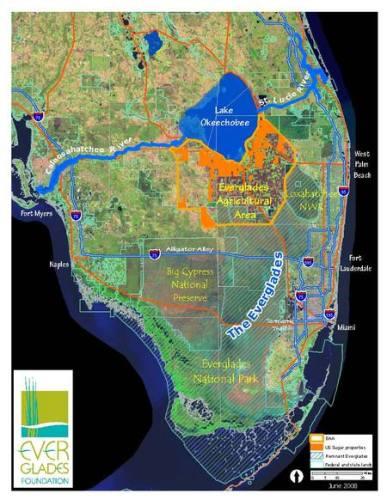A $197 million land purchase aimed at improving water flows through the Everglades has been approved by the South Florida Water Management District, but it falls far short of the original proposal. Still, groups are applauding it as a step in the right direction.
The purchase from U.S. Sugar Corporation involves just 26,800 acres, a far cry from the initial 187,000 acres Florida Gov. Charlie Crist envisioned back in 2008.
Still, proponents hope it will contribute to straightening out a kink in the natural plumbing of the region. Developments such as the sugar plantation have disrupted natural water flows from the lake into the park. Without them, the so-called "River of Grass" can't survive.
According to the South Florida Wildlands Association, "(D)rained of its water and filled with pollution (the Everglades has lost 90 percent of its wading birds and no fish caught within it are considered truly safe to eat), the ecosystem today is on life support."
South Florida Wildlands, along with other environmental organizations in south Florida, believe this deal will help improve water filtration in the ecosystem and provide needed lands for wildlife.
"Aside from allowing for ‘filter marshes’ capable of extracting huge quantities of runoff and other pollutants from Everglades water (which also happens to be the public water supply for most of south Florida), removing agricultural production is the best and possibly only hope for bringing the Everglades back from the brink," a release from the group said last week. "Part of the current purchase would also provide connectivity between Florida panther habitat in the southwest corner of Palm Beach County (in state Wildlife Management Areas well utilized by one of the most endangered species on the planet) and federal, state, and tribal lands (e.g. Big Cypress National Preserve, Big Cypress Seminole Reservation, and the Okaloacoochee Slough State Forest) to the south and west."
At the National Parks Conservation Association, Dawn Shirreffs said the land purchase approved by the water district is "a prudent investment in water quality that will make restoration possible."
“The River of Grass deal will acquire 26,800 acres of agricultural land essential to increase storage, improve water quality, and relieve damaging water releases to the Caloosahatchee and St Lucie Rivers," said Ms. Shirreffs. "Acquiring this land, from a willing seller, will secure key tracts of land at the lowest possible cost.
“We applaud the South Florida Water Management District’s efforts to overcome a shifting financial climate to protect the natural environment vital to South Florida’s economic growth. This cash acquisition eliminates risks associated with financing while preserving the future option to acquire additional lands from U.S. Sugar in the Everglades Agricultural Area," she added.
How much will this purchase help Florida's fabled River of Grass? That's a good question. More than a decade ago the Clinton administration promised to embark on an expansive, and expensive, plan to restore the Everglades. That project was seen as a way to restore, preserve, and protect the South Florida ecosystem while providing for other water-related needs of the region, including water supply and flood protection. With an estimated total cost of $10.7 billion to the federal government and $11.8 billion to the state of Florida, the initiative is the largest hydrologic restoration project in U.S. history.
While the massive restoration project has been moving forward in fits and starts, the Obama administration has promised to keep whittling away at it.
The Omnibus Appropriation Act for fiscal year 2009 provided a total of $241 million for Everglades’ projects, including $118 million from the Department of the Interior and $123 million from the U.S. Army Corps of Engineers. And last year another $119.2 million was provided through the American Recovery and Reinvestment Act.
A significant step forward came late last year when funding was provided for a mile-long section of bridge along the Tamiami Trail to help improve water flows through the Everglades.
The Tamiami Trail was constructed in the 1920s with the intention of linking Tampa and Miami, hence its name. The latest bridge project, which is expected to be completed in May 2013, is located in Miami-Dade County, adjacent to the northern boundary of Everglades National Park.
The process to reach agreement on the bridge was at times complex and time-consuming, involving many stakeholders and subject to rigorous environmental review. In November, the Army Corps of Engineers awarded an $81 million contract that includes constructing the bridge, and raising and reinforcing an additional 9.7 miles of the trail.
As a major component of the Modified Water Deliveries Project – also known as Mod Waters – the bridge will specifically restore more natural water flow to Northeast Shark River Slough, a portion of Everglades National Park that Congress added in 1989. Once completed, Mod Waters will provide a foundation for other restoration projects that will be implemented in the future to increase the quantity, quality, timing and distribution of fresh water to the Everglades.




Add comment